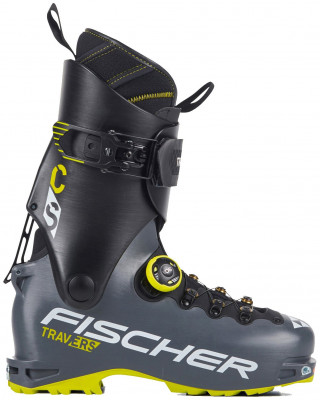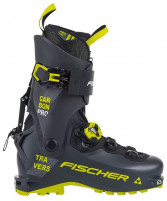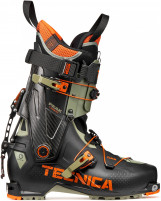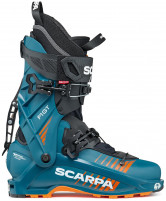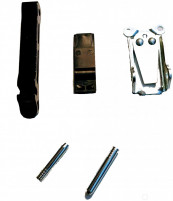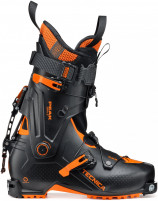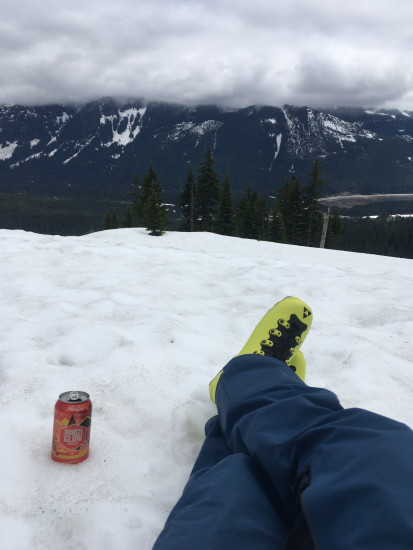Fischer Travers CS Boot
It used to be that Search and Rescue operators recommended that b*ckcountry (can't use the full word, gotta keep Big Backcountry off our case) recreationists take mirrors to signal for help when they get lost-- not anymore!! Nowadays, if you're in the backcountry and need a rescue, simply find a long stick and hold your Fischer Travers CS boots up in the air, and their glowing green hue will attract every rescuer within a 15-mile radius. In addition to their hi-vis paint job, the Travers CS boots have a spec sheet that tick's nearly every necessary box on the "What Backcountry Skiers Want" list. A huge range of motion in the ankle, the super-adjustable Boa lower-boot closure system, and a stiff carbon sole are just a few reasons to grab a pair of these featherweight touring boots for yourself. Fischer's nifty stance-improving technology, Somatec, positions your feet in a faint v-shape that improves power transfer down to your ski edges, while the Grilamid lower shell takes a punch better than Mohammed Ali (the Skimo Co boxing team? Featherweight division only). If you like skin tracks, soft snow, and long days, then Fischer Travers CS ski boots are sure to be a perfect companion for all your snowy endeavors.
- With a kevlar sole, the Travers CS is designed to be solid and stiff and able to handle hard skiing with minimal shell flex and slop.
- An adjustable velcro strap and sliding buckle make for easy and fast transitions.
- A notch in the back cuff of the boot beds the ski/walk lever and eliminates unintentional transitions while booting and scrambling.
- Brass rollers smoothly allow the Boa cable to tension the lower boot without any hotspots.
- The Grilamid lower shell can be punched to accommodate odd and strange feet.
- Soma Tech, Fischer’s secret sauce, angles your feet outward three degrees for a more natural, powerful stance.
- Toe and heel lugs make automatic crampon attachment easy and fast.
Update 2022/23: A new colorway means these boots can no longer be used to flag down Search and Rescue. Fischer also added a new beefier adjustable sliding buckle for a 31g weight increase from the previous iteration.
Update 2023/24: Fischer is keeping it fresh with another change in colorway. No changes to the construction of the boot.
| Specifications | |
|
Weight |
1075g [27.5] |
| Weight (pair) | 2150g [27.5] |
|
|
BOA + Tour 45mm + Buckle |
|
Boot Sole |
266mm [24.5] 276mm [25.5] 286mm [26.5] 296mm [27.5] 306mm [28.5] 316mm [29.5] 326mm [30.5] |
|
Binding |
Tech only |
|
Cuff |
80° |
|
Forward |
14° + Velcro spoiler |
| Specs Verified | Yes |
| Design | |
|
|
Grilamid shell, Carbon in the sole |
|
|
Custom moldable Palau |
|
|
No-Torsion |
| Skimo Co Says | |
| Usage | Ski Touring, Ski Mountaineering |
| Notes | Carbon sole added for better power transmission |
| Bottom Line | A perfect balance between up and downhill performance |
| Compare to other Touring Boots | |
Related Products
Questions & Reviews
The Tour Lite Pro (or similar) would be the usual recommended drop-in replacement for the stock liner. If you need to take up some space, I'd recommend trying the Palau Power LT , which is a little thicker but still walks well. We have it in size 29 which should work for you!
My boot liners almost worn out. I wonder if there is replacement liners available from fischer or 3rd party one?
Thank you
Zesheng
This liner from Palau would be a good replacement liner - Lite.
You could probably ski the Weston Summit Carbons with this boot. In crud or other conditions where you want more power, they might feel a little soft, but in ideal conditions, they should be alright. Keep in mind that the lateral stiffness of these boots is plenty, it's primarily the forward stiffness that is the limiting factor. So keeping that in mind, I'd recommend sizing down length-wise a bit.
Right now I'm in a pair of Fischer Rangers and they fit great and ski great on my touring skis (Rossignol Blackops Alpineer 96) , but want to get something lighter that I can use both on these skis as well as a pair of race skis (someday)
Great downhill ski boot in normal backcountry conditions, quick and easy cuff lock action. I wouldn't charge at a resort with them but would have no issue, casually resort skiing with them. Hopefully that distinction makes sense.
Downsides: a bit of a hassle to take off IMO ( especially in a tent) and the soles are pretty thin so if you are going to be out long in temperatures below minus 15 F I'd recommend a far better insulation type foot bed under liner, the liner itself is also a hair thinner than standard IMO, boot glove needed in those temps also if out long enough.
Overall a great boot, I'd give them 5 stars if I lived in a less cold climate.
My question is, can these boot be expected to perform downhill with my Volkl Rise Beyond 96 at 184 with Ski Trab Titan Vario? I’m 6’1 185.
The Palau Tour Lite Pro liner is going to be the closest to the stock liner in terms of volume and fit.
I'm considering this boot or the TLT8 Exp. How would you compare/contrast the downhill performance between these? I ski a voile objective in mostly hard and packed conditions. Both boots fit similarly mediocre in their own ways.
Since boot performance is often as much about fit than anything else, I'll describe my feet and some ski boot history.
My feet: I struggle with my feet and my first 5-15 tours of every season are all about breaking my feet in. I typically get blisters on both my heels and on my talus. I have a six toe on my left foot and a bunion on my right. I have low arches, a wide forefoot, mid-volume overall, and a skinny heel. If Dynafit still made the Vulcans I'd still be using those, but finally, I found a boot that I'm very happy with. So maybe if you got along well with Vulcans, you will get along with the Travers also.
Past history with boots: I've used Dynafit Hojis, a couple of pairs of Dynafit Vulcans, Sportiva Sytrons, Scarpa Maestrales, Scarpa Denalis, some 130 flex BD boots that I forget the name of, and different types of Scarpa tele boots.
Downhill ski performance is good for the weight class and with both 85 underfoot and 95 underfoot skis. I haven't had any issues with cold feet. Without having skiied too many other boots in this weight class it's hard to say it skies better or worse than the F1 or the Backland (for instance), but it skis well. It does feel soft, progressive, and predicatable.
Outdoor Gear Lab reported that their testers felt some pain in their achilles tendon after/while skinning. After skiing three days in a row I've gotten that a bit, too, in my right foot, although it's not been severe enough to be a problem--nothing beyond merely noticing an uncomfortable sensation. At no point has it been enough to make me think of cutting a tour short nor having to adopt a "suffer-through-it" mindset.
The Boa dial seems great for my foot. I can imagine that those with skinny mid- and forefeet may miss the buckles to crank it down, or perhaps need to go with a somewhat thicker sock. A WildSnow reviewer noted that having to push the tongue down so that the tongue baffles lay flat across the foot is minorly annoying, but it hasn't bothered me a bit. It's quick, and I only need to do it once when I put my boots on.
The boots are more of a pain to get off than my Hojis. On is quick.
I wish that the velcro strap was a bit taller. I think that this would be a reasonable way to add a bit more downhill support for just a small weight penalty.
Uphill performance:
Extremely light on feet. Really great in walk mode. Sole is not vibram but feels very similar and grippy.
Downhill performance:
Leaves a lot to be desired. I tent to ski these boots pretty conservatively as a result. Hoping that I gain confidence the more I ski them.
Overall:
I think that the downhill compromise is well worth the uphill performance. As someone who tours more for fitness than to ski big lines, they make a lot of sense when paired with a lightweight uphill-oriented setup. I wouldn’t pair these with a burly setup expecting major downhill performance.
Great question! Based on your dimensions, I would recommend a ski in the low to mid 170cm range. Based on that, the Fischer Travers CS has plenty of power for a ski that is in the 80-95mm range. For a ski that is 95+mm, your question becomes more subjective.
For a skier your size, in softer snow, I think you will have plenty of boot for a ski up to 100mm. If you are charging hard in firm conditions, a ski that is 100mm or more will probably start to feel under-powered with the Travers CS. Alternatively, really soft powder is super forgiving, and you could probably drive a ski without issue that is over 100mm. If you have further questions, reach out to us at help@skimo.co!
I'm A very tight 28 or a loose 29 in the older TLT6. I still ski both. And 29 TLT8 which seems sloppy. And a tight 28 in most everything else Scarpa and La Sportiva. What size would you suggest in the CS? Thanks.
I have race boots Fischer The Curv One 130 HV which are 105mm wide (last) in my size 28.5. I am a little bit narrow into it.
Which is the wider for wide foot : This Fisher travers CS or the Dynafit PDG2 ?
I have heard Travers CS is 104mm last in size 28.5, which is narrower than my race boots.. is that correct ?
What is the last of the Dynafit PDG2 in size 28.5 ?
Thank you.
The PDG 2 essentially is a downsized TLT7, meaning a 28.5 PDG2 is a 27.5 TLT7 with a thinner liner. Because the comparison between a PDG2 and Travers isn't even (they are in different categories), I would give a slight edge to the Travers in terms of room based on a shell fit, but only because it isn't downsized like a race boot is supposed to be. Please let us know if you have any other questions!
Earn store credit by writing reviews. Learn more.






